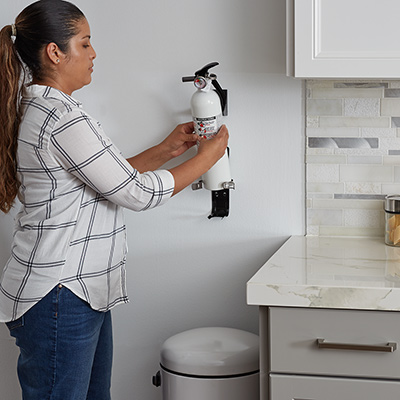Types of Fire Extinguishers

Last updated December 1, 2023
Fire extinguishers are made to help you quickly stop or escape a fire. Just like there are different types of fires, there are different types of fire extinguishers. Use this guide to understand all the fire extinguisher types and the classes of fire extinguishers. Plus, find out how to use and store your extinguishers properly.
Table of Contents
Fire Extinguisher Facts
Fire Extinguisher Types
Classes of Fire Extinguishers
A:B:C Fire Extinguishers
Selecting Fire Extinguishers
PASS: How to Use a Fire Extinguisher Safely
Fire Extinguisher Facts

Fire extinguishers are categorized by types and classes. A fire extinguisher’s class refers to the type of fire it puts out. A fire extinguisher's type refers to the substance or agent it contains to put out that fire.
For example, one of the most common fire extinguishers are Class K. Class K extinguishers are filled with an agent designed to prevent burning grease from splattering and spreading. These types of fire extinguishers are the ones most often found in home kitchens. Since most kitchen fires are small and in a tight area, Class K fire extinguishers use a high-volume, low-velocity spray. Class K is a sub-class of Class B fire extinguishers.
Tip: Prevent kitchen fires by always cleaning up spills and double-checking that you've turned off all burners.
Fire Extinguisher Types

Different types of fire extinguishers are filled with different agents.
- Water extinguishers use water to cool down and smother the fire.
- Foam extinguishers use a foam substance to smother the fire.
- Dry chemical extinguishers have a powder to coat fuel and prevent it from reigniting.
- CO2 extinguishers work by removing oxygen from a fire.
- Wet chemical extinguishers are made for fires involving oil or grease.
Classes of Fire Extinguishers

There are four main classes of fire extinguishers: A, B, C, and D.
- Class A extinguishers are rated for fires that involve ordinary household items such as wood, cloth, paper, rubber and plastics. Numbers on a Class A extinguishers measure its fire-fighting capacity in water volume. For example, Class 1-A extinguishers have the equivalent of 1.25 gallons of water and a 4-A has 5 gallons.
- Class B extinguishers are rated for flammable liquid fires such as kitchen grease, gasoline, oil, solvents and oil-based paint. The number on a Class B extinguisher refers to square feet of power it can put out. For example, a 10-B extinguisher can cover 10 square feet of fire.
- Class C extinguishers are rated for fires involving energized electrical equipment such as wiring, circuit breakers, machinery, electronics and appliances.
- Class D fire extinguishers are used in industrial or laboratory buildings. These extinguisher types contain extinguishing agents for combustible metals, such as titanium, magnesium, aluminum, and potassium.
A:B:C Fire Extinguishers

A:B:C fire extinguishers work for all kinds of fires. These types of fire extinguishers can also be labeled A-B or B-C. The National Fire Protection Association encourages portable, multi-purpose fire extinguisher use when:
- The fire is confined to a small area, such as a wastebasket, and is not growing.
- Everyone has exited the building.
- The fire department has been called or is being called.
- The room is not filled with smoke.
Selecting Fire Extinguishers

Keep yourself safe and ready to contain or put out a fire anywhere in your home. The National Fire Protection Association (NFPA) recommends:
- Place at least one 2-A, 10-B or C fire extinguisher on every level of your house or apartment. Put them near exits to create an exit pathway. Make sure they are no more than 40 feet apart.
- For kitchens and vehicles, use classes and ratings that are Class K, 10-B and C. Keep one under your kitchen sink or in your trunk for quick access.
- For garages, workshops, home theaters and offices, the recommended classes and ratings are 3-A, 40-B and C.
PASS: How to Use a Fire Extinguisher Safely

When using any fire extinguisher, keep the acronym PASS in mind.
- "P" stands for pull the pin.
- "A" stands for aim the nozzle toward the base of the fire.
- "S" stands for squeeze the lever slowly.
- "S" stands for sweep the nozzle from side-to-side, while moving toward the fire.
Tip: Make sure there's a clear exit when you use a fire extinguisher. This will allow you to escape quickly if the fire can't be controlled.
Fire Extinguisher Safety Tips

- Replace your fire extinguisher if the gauge reads empty, or if it is older than 12 years.
- Check with local fire departments for find hands-on fire extinguisher training.
- Choose an extinguisher with an easy-to-read pressure gauge and clear instructions.
- Bigger is better when choosing an extinguisher.
- Maintain your extinguisher by checking the gauge monthly to ensure it is pressurized.
- Check your smoke detectors, CO alarms and fire extinguishers at least once a year to ensure they are up-to-date.
A good fire response plan always includes the right fire extinguishers. Knowing the different fire extinguisher types and classes can help you select the best safety equipment for your home. Keep a fire extinguisher in your kitchen and every level of your home. Plus, make sure your smoke alarms work and you practice a fire escape plan regularly. Ready to get the right type of fire extinguishers for your home? The Home Depot delivers online orders when and where you need them.































